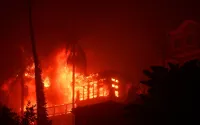Poor women cooking family meals in India are helping to melt the Arctic icecap, startling new studies show. Soot from their fires gets wafted into the atmosphere to fall out on the ice thousands of miles away, hastening its disappearance.
In a vivid demonstration of interconnectedness, Nasa scientists have found that one-third of the soot affecting the Arctic comes from South Asia. And Indian studies show that nearly half of the soot emitted in the region comes from cooking fires. Last November a major study by some 300 scientists found that the icecap had thinned by nearly half over the past 30 years. It is expected to disappear altogether by 2070, leaving open water all the way to the North Pole.
The scientists concluded that the Arctic is heating up twice as fast as the rest of the globe. Mostly this is due to worldwide pollution by carbon dioxide and the other "greenhouses gases" that cause global warming. But Dorothy Koch of Nasa and Columbia University, New York, says that the new research suggests that soot may also "have a significant warming impact on the Arctic".
Tiny soot particles both warm up the air, and darken the surface of the ice when they fall out in the Arctic. The darker surface then absorbs more sunlight, causing the ice to melt faster.
The Nasa scientists were amazed to find that only one-third of the soot reaching the ice came from the nearby industrialised countries of Europe, and North America and the former Soviet Union.
A similar amount results from burning vegetation around the world, with the final third coming from South Asia. And the Indian subcontinent provided most of the soot falling out on Greenland. "The standard knowledge has always been that most of the soot comes from northern Europe and Asia," says Dr Koch. "We were surprised to find that much of it comes from further south." It travels that far, says Nasa, because meteorological conditions over the Indian subcontinent readily lift it into the upper atmosphere to be transported to the North Pole, while the pollution from northern industrialised countries stays closer to the ground.
South Asia puts out more soot from its industrial chimneys than anywhere else on Earth, but even this is dwarfed by the smoke from millions of cooking fires. Research at the Indian Institute of Technology in Bombay has found that more than 40 per cent of the soot in the air comes from cooking, with another 13 per cent from forest fires. It concluded that the warming effect of the soot was 10 times as great as greenhouse gases over the Indian Ocean.
Even before this discovery, the cooking fires of the poor were known to be one of the world's gravest environmental hazards. A cocktail of poisonous chemicals swirling in the smoke from dung or wood fires kills 2.2 million people a year - mainly women cooking on them and their children.
The United Nations Environment Programme says they are responsible for 5 per cent of the world's disease - more than HIV/Aids - and cost the world economy up to £400bn a year in lost production through sickness and death.
Yet worldwide two billion people have to burn wood and dung because they cannot access or afford modern forms of energy. Soot from the fires is also one of the main causes of the so-called Asian Brown Cloud, a vast pall, two miles thick, that hovers over the south of the continent, reducing the amount of sunlight that reaches the ground by up to 15 per cent.
Now the Nasa study shows that it may also have global effects. Dr Koch says that the soot has "potentially long-term implications on climate patterns for much of the globe". So as the Greenland ice-sheet melts, flooding in the Thames estuary may be caused by the cooking of sparse meals far away in the Indian countryside.






